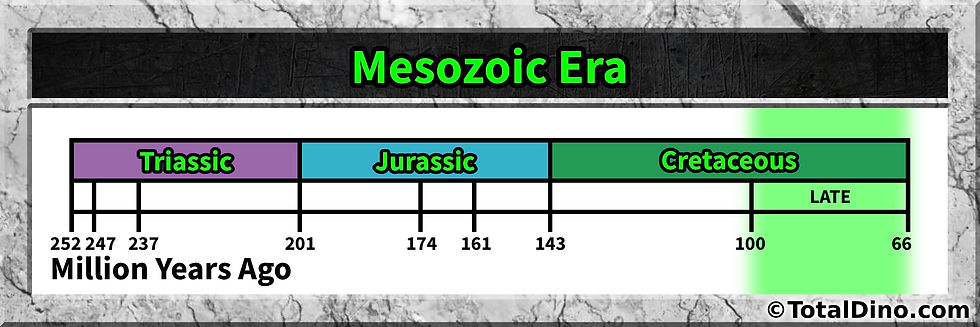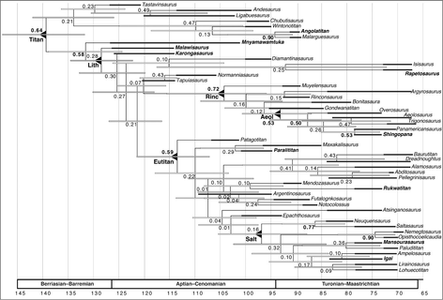Igai
- Total Dino
- Oct 26, 2024
- 3 min read
Updated: Sep 18
MEANING: Lord of the oasis
PERIOD: Late Cretaceous
CONTINENT: Africa
Igai was slender for a titanosaur, estimated to have reached around 10–15 m in length. Its discovery strengthened a hypothesis that Late Cretaceous titanosaurs in northern Africa and Europe tended to be relatively small. This is in contrast to their counterparts from southern Africa, which seemed to have evolutionary origins from the Gondwanan continent.

Abstract from paper: Dinosaur fossils from the latest Cretaceous (Campanian–Maastrichtian) of Africa and the Arabian Peninsula are rare. Most discoveries to date have consisted of limited fossils that have precluded detailed phylogenetic and paleobiogeographic interpretations. Fortunately, recent discoveries such as the informative Egyptian titanosaurian sauropod dinosaur Mansourasaurus shahinae are beginning to address these long-standing issues. Here we describe an associated partial postcranial skeleton of a new titanosaurian taxon from the Upper Cretaceous (Campanian) Quseir Formation of the Kharga Oasis, Western Desert of Egypt. Consisting of five dorsal vertebrae and 12 appendicular elements, Igai semkhu gen. et sp. nov. constitutes one of the most informative dinosaurs yet recovered from the latest Cretaceous of Afro-Arabia. The relatively gracile limb bones and differences in the coracoid and metatarsal I preclude referral of the new specimen to Mansourasaurus. Both model-based Bayesian tip-dating and parsimony-based phylogenetic analyses support the affinities of Igai semkhu with other Late Cretaceous Afro-Eurasian titanosaurs (e.g., Mansourasaurus, Lirainosaurus astibiae, Opisthocoelicaudia skarzynskii), a conclusion supported by posterior dorsal vertebrae that lack a postzygodiapophyseal lamina, for example. Igai semkhu strengthens the hypothesis that northern Africa and Eurasia shared closely related terrestrial tetrapod faunas at the end of the Cretaceous and further differentiates this fauna from penecontemporaneous assemblages elsewhere in Africa, such as the Galula Formation in Tanzania, that exhibit more traditional Gondwanan assemblages. At present, the specific paleobiogeographic signal appears to vary between different dinosaur groups, suggesting that Afro-Arabian Cretaceous biotas may have experienced evolutionary and paleobiogeographic histories that were more complex than previously appreciated.
Igai is from the Late Cretaceous. The Cretaceous is the third and final geological period of the Mesozoic Era, with the Late Cretaceous making up roughly the second half of it, lasting from about 100 to 66 million years ago. It was a time of significant evolutionary change, with dinosaurs reaching their greatest diversity before the mass extinction at the end of the Cretaceous.
The Cretaceous was a period with a relatively warm climate, though the Late Cretaceous experienced a global cooling trend, caused by falling levels of carbon dioxide in the atmosphere. The continents were nearing their present positions, but high sea levels flooded low-lying regions, turning Europe into an archipelago, and forming the Western Interior Seaway in North America. These seas were home to a variety of marine reptiles, including mosasaurs and plesiosaurs, while pterosaurs and birds shared the skies.
On land, dinosaurs continued to thrive and diversify during the Late Cretaceous, producing many of the most well-known goups, including tyrannosaurs, hadrosaurs, and pachycephalosaurs. Established Cretaceous dinosaur clades like the ceratopsians, ankylosaurs, and dromaeosaurs continued to flourish. Sauropod species consisted almost exclusively of titanosaurs, which seemed to be confined to the Southern Hemisphere for much of the Late Cretaceous. Flowering plants and grasses diversified and spread, becoming the dominant flora similar to what we see today.
The Cretaceous (along with the Mesozoic) ended with the Cretaceous-Paleogene (K-Pg) extinction event, a large mass extinction in which many groups, including non-avian dinosaurs, pterosaurs, and large marine reptiles, died out. This event, likely triggered by an asteroid impact, is marked by the abrupt K-Pg boundary, a distinct geologic layer separating the Mesozoic and Cenozoic Eras. In its aftermath, mammals and avian dinosaurs rapidly diversified, becoming the dominant land animals of the Cenozoic Era.

Igai is a saltasauroid titanosaur. Saltasauroids are a clade of derived titanosaurs that thrived during the Late Cretaceous and are among the last and most specialized members of the sauropod lineage. They are primarily known from South America, though fossils have also been found in Asia and elsewhere. These sauropods tended to be smaller and more compact than their earlier relatives, with some species estimated to have been under 15 meters in length - small by sauropod standards. Despite their reduced size, they retained the characteristic long necks and tails of their lineage.
One of the most distinctive traits of saltasauroids is the presence of bony armor, or osteoderms, embedded in their skin - a rare feature among sauropods. This dermal armor suggests a possible evolutionary response to increased predation pressures during the Late Cretaceous. Their skeletons often show adaptations toward a more robust and stocky build, possibly indicating changes in locomotion or lifestyle compared to earlier titanosaurs. As one of the last surviving sauropod groups before the end-Cretaceous extinction, saltasauroids represent the final phase in the long evolutionary history of these giant herbivores.













